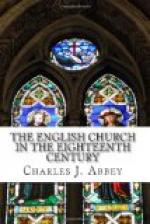The strongly marked division of opinion which had prevailed during the reign of Elizabeth and Charles I. as to the mode of observing Sunday no longer existed. Formerly, Anglicans and Puritans had taken for the most part thoroughly opposite views, and the question had been controverted with much vehemence, and often with much bitterness. Happily for England, the Puritan view, in all its broader and more general features, had won peaceful possession of the ground. The harsher and more rigid observances with which many sectarians had overburdened the holy day, were kept up by some of the denominations, but could not be maintained in the National Church. In fact, their concession was the price of conquest. Anglican divines, and the great and influential body of laymen who were in accord with them, would never have acquiesced in prescriptions and prohibitions which were tenable, if tenable at all, only upon the assumption of a Sabbatarianism which they did not pretend to hold. But the Puritan Sunday, in all its principal characteristics, remained firmly established, and was as warmly supported by High Churchmen as by any who belonged to an opposite party. It has been aptly observed that several of Robert Nelson’s remarks upon the proper observance of Sunday would have been derided, eighty or a hundred years previously, as Puritanical cant by men whose legitimate successors most warmly applauded what he wrote.[1262] No one whose opinion had any authority, desired, after Charles II.’s time, to revive the ’Book of Sports,’ or regretted the abolition of Sunday wakes. Amid all the laxity of the Restoration period—amid the partial triumph of Laudean ideas which marked the reign of Queen Anne—amid the indifference and sluggishness in religious matters which soon afterwards set in—reverence for the sanctity of the Lord’s Day, and a fixed purpose that its general character of sedate quietness should not be broken into, grew, though it was but gradually, among almost all classes, into a tradition which was respected even by those who had very little care for other ordinances of religion.
Such, undoubtedly, was the predominant feeling of the eighteenth century; and it is difficult to overestimate its value in the support it gave to religion in times when such aid was more than ordinarily needed.
There are many aspects of Church life in relation to the social history of the period which the authors of these chapters are well aware they have either omitted entirely, or have very insufficiently touched upon. It is not that they have undervalued their interest as compared with matters which have been more fully discussed, but simply that the plan of their work almost precluded the attempt at anything like complete treatment of the whole of a subject which may be viewed from many sides.
C.J.A.
FOOTNOTES:
[Footnote 838: Review of Milner’s Church Arch, in Q. Rev. vol. vi. 63.]




